- Home
- Article
Thinking of Buying: Patient Warming Solutions
By: Joe Paone | Senior Editor
Published: 11/14/2022
The key is finding a system that best matches your unique needs.
No matter how long you actively warm your patients or when you opt to do it, one basic but crucial factor in the equation is the devices you use to do it in the first place. The many variables involved, not to mention the many options on the market, each offering a relatively unique take on the concept of maintaining normothermia and staving off hypothermia, make the purchasing decision a difficult one for surgical leaders. Chances are, though, if you look closely enough, there’s a system to match up with your budgetary requirements and procedural needs.
Darlene Dierkes, MSQA, BSN, RN, CNOR, CHL, president of Summit Surgical Counseling in Yucaipa, Calif., and a veteran director of perioperative services, says the primary factors to focus on when evaluating active warming systems are reading up on the literature and determining the real costs of each system, including any disposable aspects. Additional considerations are the footprint of the unit and whether you have enough space for it; whether any hoses or wires involved can be easily hung on the machine when not in use to avoid tripping hazards; and how long the electrical cord is.
There are three basic types of active patient warming systems: forced-air warmers, circulating water mattresses and conductive fabric warming blankets. Daniel Mills, MD, FACS, a plastic surgeon who is owner and medical director at Oceanview Ambulatory Surgery Center in Laguna Beach, Calif., has been employing multiple active warming systems for the last decade or so due to the variety of procedures he performs. “A lot of it has to do with how much square surface area the patient has exposed,” says Dr. Mills. For example, he uses a forced-air system for patients undergoing facelifts, but for a full-body liposuction, he employs a circulating water mattress. “When we’re doing a full body lipo where essentially everything is exposed except the head and the knees down, it’s hard to keep patients warm enough,” he says. “In those situations, you need to use something where you have heat underneath them.”
Dr. Mills views temperature management and monitoring in association with the use of active warming systems as vital. “We monitor patients’ temperatures very carefully, based on how many square centimeters they have exposed, and kind of play it by ear,” he says. “If we’re doing a full tummy tuck or full body liposuction where a significant amount of the body is exposed, we really have to monitor their temperature very well.” On the other hand, he says, when he’s doing a facelift and the patient is under a warming blanket, frequently they’ll get too hot to even have the system on. “They’ll start sweating and bleed more in their head because that’s the only thing that’s exposed, and we need to be careful not to get them too hot,” Dr. Mills says.
As we describe in the product roundup accompanying this article, numerous systems available now provide exacting real-time monitoring and adjustment capabilities to help providers ensure the patient is at the right temperature at all times during their entire perioperative episode.
Dr. Mills additionally recommends investigating the costs of disposables associated with the systems you are evaluating. “The disposables can be problematic because the more money you have to put in towards it, the less affordable surgery can be,”
he says, adding that hospitals don’t need to consider the costs as much as he must as the owners of an ASC.
He also advises leaders to plan ahead in terms of where the system will be placed in perioperative areas to avoid any tripping hazards.
“For example, in the OR, we put our water unit right next to the anesthesia machine and have it configured so it goes in near the patient’s right shoulder,” he says. “Since the anesthesia machine is there, we’re really
not stepping over that because it’s tucked away.”
When he first started using patient warming systems, a high degree of skepticism still existed about the helpfulness of the intervention. However, a number of Dr. Mills’ patients back then who were totally exposed had developed hypothermia. “When they’re hypothermic, they don’t wake up for three or four hours, so I had to do something,” he says. Enter the use of active warming, something Dr. Mills says “has worked very well for us.” OSM
TRENDELENBURG EXCLUSIVE
Augustine Surgical
HotDog Temperature Management System
hotdogwarming.com • 888-439-2767
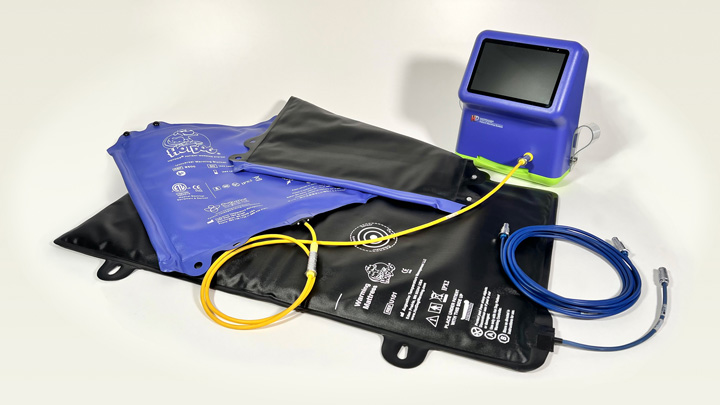
The vendor says this system can deliver superior normothermia results by warming above and below the patient simultaneously using flexible, versatile blankets and mattress overlays. The system, which employs proprietary semi-conductive fabric technology that actively warms patients without blowing air or using water, is described as commonly used in orthopedic, cardiac, plastic, general and robotic surgeries, and the only system that can both warm and secure patients in the Trendelenburg position.
SLIM AND QUIET
Encompass Group
Nova
encompassgroup.com • 800-284-4540
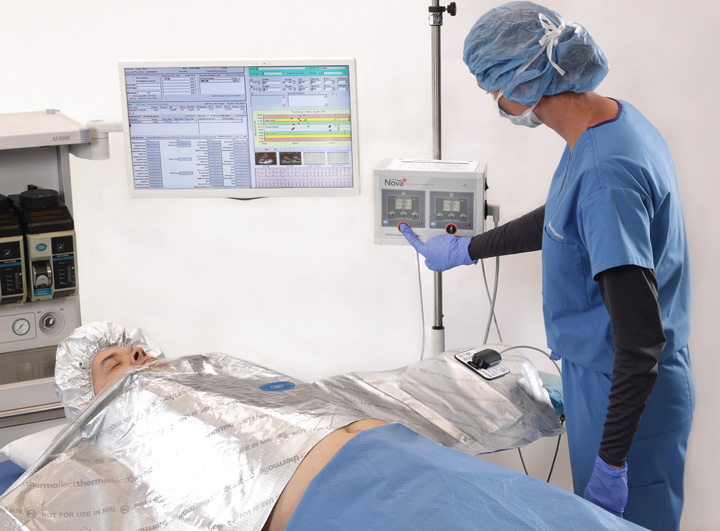
The vendor says this thin, disposable patient warming blanket operates without the noise of forced-air systems — in fact, it is described as “silent.” Its novel carbon veil technology, which uses less than five amps for heat and is manufactured similarly to paper, has long been used as a heater in car seats and features no air movement. When applied in pre-op, it banks a patient’s body heat before surgery even when unpowered, and then supports maintaining normothermia throughout the surgical process — all without air movement or moving parts. Available in upper and lower body versions, it is touted as easy to apply, and is said to stay in place once applied. The soft-touch controller unit, described as intuitive to operate and universally pole-mountable, features adjustable temperature settings and a large temperature display, and can independently manage two blankets simultaneously to maximize skin coverage. Because the blanket doesn’t emit excess heat, patients can stay warm while clinicians remain cool during surgery. The blanket is flexible enough that it can still maintain performance after cuts or spills, and its small-profile cable can be secured easily with its integrated linen clip to reduce tripping hazard risk.
QUIET AND COMFORTABLE
Gentherm
ASTOPAD
gentherm.com • 800-989-7373
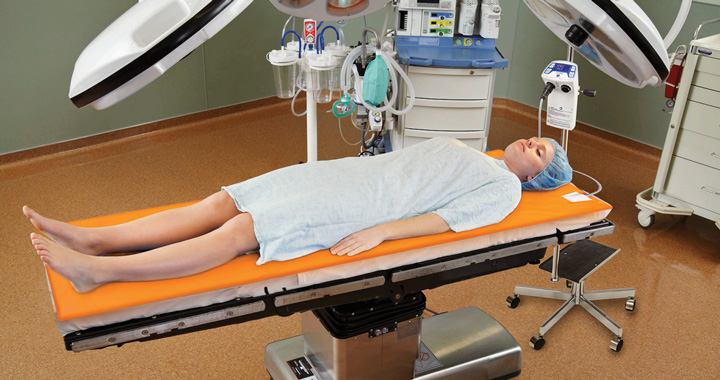
This resistive, reusable patient warming system, described as safe and simple to operate, features two independently controlled connections that enable the patient’s full body to be warmed simultaneously. Warming blankets, which employ the vendor’s proprietary silent radiolucent heating technology also used to heat seats in millions of vehicles, can be placed over or underneath the patient, and temperature settings can be set individually in precise 0.5°C increments. Featuring an integrated rechargeable battery with two hours of continuous use to allow warming to continue uninterrupted during transport, each blanket features eight temperature sensors and can be wrapped around the patient while in use for increased versatility in positioning. The blankets can be used in conjunction with positioning devices on OR tables, and can be easily wiped down with approved disinfectants.
ADDED ASSURANCE
STERIS
Patient Warming System
steris.com • 800-548-4873
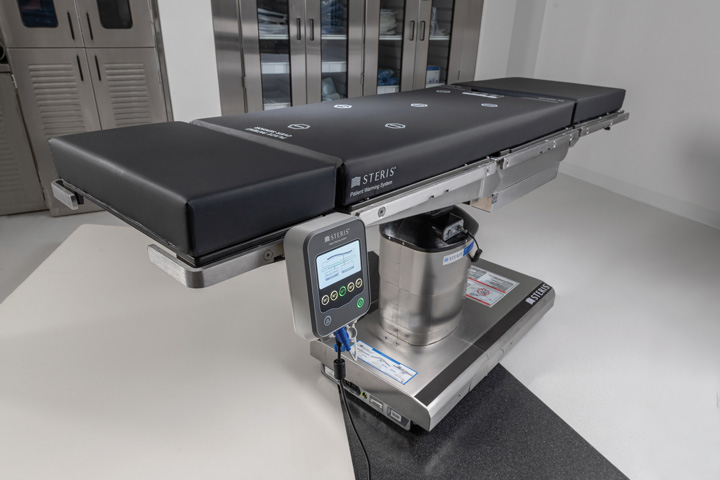
This accessory, meant to augment rather than replace current warming protocols, employs conductive heat transfer through direct contact between the patient and the table. Consisting of a heated surgical table pad and optional overbody blanket that the vendor says isn’t too bulky, it is intended to provide additional warming before, during or after conductive air warming technologies are used in the OR. Its controller, which can be mounted to the table side rail or an IV pole, features thin, easy-to-connect cables. The system also includes a three-inch heated torso pad and three-inch pads for head and legs. The vendor says the system is particularly helpful for shorter surgeries where postoperative hypothermia is more likely due to the lack of time needed to overcome the effect of redistribution with intraoperative warming alone. It recommends providers start the system as soon as possible when the patient arrives and prior to induction of anesthesia.
PRECISE CONTROL
Stryker
Altrix Precision Temperature Management System
stryker.com • 800-784-4336
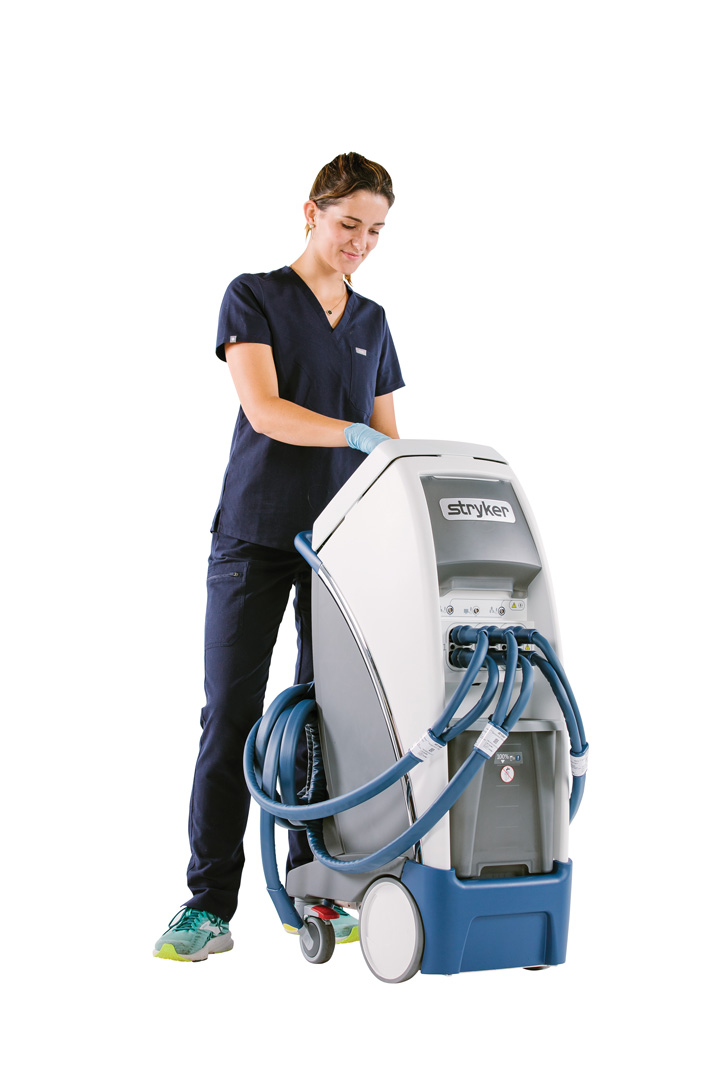
This system provides a high level of granular control, employing thousands of power settings to measure the patient’s temperature every 1.3 seconds to achieve steady-state control within ± 0.1° C. Its non-gel-adhesive, non-invasive disposable, adjustable three-layer wrap kits — made of soft, non-woven, spun-bonded polyester fabric and able to accommodate 99% of adult patients — enhance thermal transfer and protect skin integrity with increased surface area contact to reduce air gaps that can occur between cooling/warming devices and patient skin. Three unique modes allow providers to set water temperature alone, or precisely control patient temperature through rapid device-patient interaction. A user-friendly graphic control interface features prompts that allow providers to initiate patient therapy with just a few finger taps, and provides key temperature management treatment data including patient temperature, target temperature, water temperature, timing and power levels. Three individually monitored water circuits regulate water temperature and flow performance to ensure optimum therapy delivery.
COMPREHENSIVE COVERAGE
3M
Bair Hugger Flex Warming Gown
FYI: 3m.com • 800-364-3577
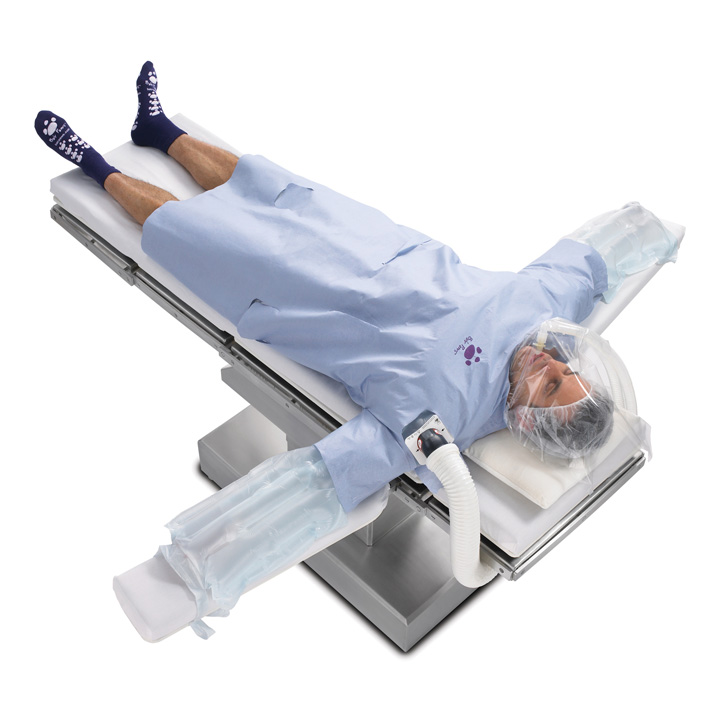
Designed to address and simplify the entire perioperative warming process while entirely removing the need for warmed blankets, this gown features two independent inserts that allow for greater flexibility to warm the upper body, torso or lower body. Because of this capability to cover numerous parts of the entire body, the gown can be used to warm patients for virtually any procedure or specialty. Applicable for both clinical or comfort purposes, the warming tools built into the gown include a head drape, tie strips and a patient adhesive strip. Described as quiet, lightweight and easy to use, the patient-adjustable warming unit connects to the gown to provide the necessary air flow, and can be located on a wall, bedrail, IV pole, table or any flat surface.
.svg?sfvrsn=be606e78_3)
.svg?sfvrsn=56b2f850_5)